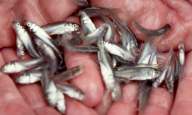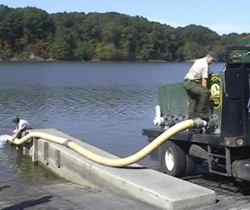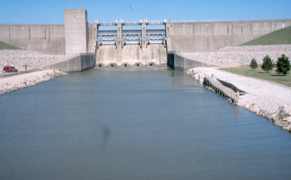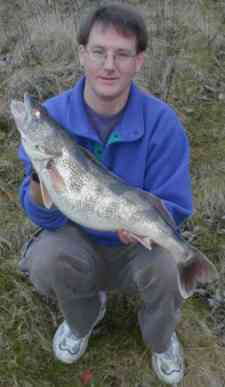 Saugeye
naturally occur in nature where walleye and sauger coexist, as in
the
Ohio River. However, most saugeye are
produced in Division of Wildlife hatcheries. Saugeye parents are
collected from
Ohio waters: sauger males are
collected from the
Ohio River and walleye females are
collected in the March from lakes such as
C. J. Brown,
Mosquito and
Berlin.
Saugeye
naturally occur in nature where walleye and sauger coexist, as in
the
Ohio River. However, most saugeye are
produced in Division of Wildlife hatcheries. Saugeye parents are
collected from
Ohio waters: sauger males are
collected from the
Ohio River and walleye females are
collected in the March from lakes such as
C. J. Brown,
Mosquito and
Berlin.
The Division of
Wildlife’s first successful saugeye production occurred in 1977
when limited numbers were raised at the Kincaid State Fish
Hatchery. In June 1978, the first introduction of saugeye
occurred in
Deer
Creek
Lake. Subsequent
fish surveys at Deer Creek (pictured left) indicated favorable
survival and growth. The success of this inaugural stocking led
to the expansion of the saugeye program.
Ohio’s saugeye program has
focused on stocking saugeye where walleye introductions have been
unsuccessful and where saugeye are more likely to provide a
quality fishery.
Hatchery saugeye production recent years has been between
6 to 10 million
fingerlings per year. In 2004, 8.7 million saugeye fingerlings
were stocked into 59 water areas.
Subsequent
fish surveys at Deer Creek (pictured left) indicated favorable
survival and growth. The success of this inaugural stocking led
to the expansion of the saugeye program.
Ohio’s saugeye program has
focused on stocking saugeye where walleye introductions have been
unsuccessful and where saugeye are more likely to provide a
quality fishery.
Hatchery saugeye production recent years has been between
6 to 10 million
fingerlings per year. In 2004, 8.7 million saugeye fingerlings
were stocked into 59 water areas.
Some of the
better saugeye fishing in central Ohio can be found at
Alum Creek,
Buckeye,
Hoover, and
Indian lakes. The northwest part of the state has Paulding
and
Pleasant Hill Reservoir.
In northeast
Ohio,
Atwood,
Clendening, and
Tappan, produce excellent saugeye
fishing.
Piedmont Lake
boasts good saugeye
fishing in southeast
Ohio.
If you enjoy fishing rivers, then try fishing for saugeye in the
Muskingum
River.
In the southwest, saugeye fishing opportunities are best at
 Caesar
Creek and
Rocky
Fork lakes.
See saugeye fishing tips for all
seasons.
Caesar
Creek and
Rocky
Fork lakes.
See saugeye fishing tips for all
seasons.
Stockings in some
Ohio
onstream flood control reservoirs have also provided high
densities of saugeye in tailwater areas (the stream below the dam
of a water body- pictured right) which can provide great fishing
opportunities from November to July after high discharges of
water. Fishermen find tailwater areas, at lakes like Paint Creek
(southwest
Ohio)
and Deer Creek (central
Ohio),
attractive getaways from the traditional cabin fever ills of
winter.
Saugeye
provide excitement and are a prized sport fish to Ohio's anglers.
The current
state recordsaugeye is a 12.84 pound, 28 ¾ inch long fish
which was caught at Alum Creek in late January, 2002. See
saugeye fishing tips by season.
Is
it a Saugeye, Walleye, or Sauger?
How can you identify a
saugeye from a walleye or a sauger? Since saugers are primarily
found in the
Ohio River,
the identification problem most likely to occur is between the
saugeye and walley e.
Saugeye look similar to both the
walleye and
sauger. Saugeye have saddle-like markings on their sides,
similar to the sauger, but saugeye can have some white pigment on
the lower portion of their tail along with dark bars on the dorsal
fin membranes. Walleye do not have saddle-like markings on their
sides, have white pigment on the tail, and have solid shading on
the dorsal fin membranes.
e.
Saugeye look similar to both the
walleye and
sauger. Saugeye have saddle-like markings on their sides,
similar to the sauger, but saugeye can have some white pigment on
the lower portion of their tail along with dark bars on the dorsal
fin membranes. Walleye do not have saddle-like markings on their
sides, have white pigment on the tail, and have solid shading on
the dorsal fin membranes.
Ohio’s
saugeye management and research has
been concentrating on how to make saugeye fishing consistently
better for fishermen. Currently, research investigations are
being directed towards saugeye condition and prey availability
during the winter, spring, summer, and fall time periods.
Biologists are also examining whether later stockings of
fingerlings improve saugeye survival. Knowledge gained from
ongoing research projects will provide the Division of Wildlife
with information necessary to modify management techniques in such
a way as to substantially reduce mortality and thus improve
saugeye stocking success. This, in the long-run, will eventually
mean more saugeyes for the angler.
Reprinted courtesy, Ohio Division of Wildlife




 Saugeye
naturally occur in nature where walleye and sauger coexist, as in
the
Saugeye
naturally occur in nature where walleye and sauger coexist, as in
the
 Subsequent
fish surveys at Deer Creek (pictured left) indicated favorable
survival and growth. The success of this inaugural stocking led
to the expansion of the saugeye program.
Subsequent
fish surveys at Deer Creek (pictured left) indicated favorable
survival and growth. The success of this inaugural stocking led
to the expansion of the saugeye program.
 Caesar
Creek
Caesar
Creek e.
e.